One of the most interesting places in Mexico City is the Panteón de Dolores. Hidden away in the western corner of the Bosque de Chapultepec lies the most beautiful cemetery. Home to some of the most incredible graves sculptures found anywhere in the world. Under these stones lie some of the most illustrious people who impacted the cultural growth of Mexico City. The Panteón de Dolores is genuinely one of those true hidden gems. Many locals don’t even know the incredible treasures found here!
The Panteón de Dolores is a place where everyone can come and learn about the history of Mexico and its people. And the beauty of the gravestones and tombs makes a visit more like a trip to an open-air sculpture park. Taking a trip out to the edge of the Bosque de Chapultepec is well worth it to discover the amazing pieces of history found here.
History of the Cemetery
The history of the cemetery goes back to 1835 when William Benfield, a wealthy Englishman, moved to Mexico City. (Special thanks to Eduardo Cremer, great-great-great grandson of Benfield for helping get the history correct!) Benfield arrived with his wife Mary, who had fallen ill with tuberculosis. Their doctor in England recommended the move as the climate and altitude was thought to help people who suffered from tuberculosis. And they were right! Benfield’s wife was able to live an extra twenty years in Mexico. Shortly after arriving, Mary gave birth to their son and named him Juan Manuel.
William wanted to bring over the rest of his family, to join them in Mexico. The Benfield family arrived by boat and docked in Veracruz before making their way to Mexico City. At the time, Benfield saw that Anglicans couldn’t be buried in cemeteries in Veracruz. They were reserved for Catholics only.
Until this point, the Catholic Church controlled all cemeteries in Mexico. Juan Manuel Benfield took matters into his own hand. Benfield went to the Mexican government and asked to be granted permission to build a private cemetery.
His grant was approved and he became the first private company allowed to open a private cemetery. He used 590 acres he had set aside on his ranch to build it. Juan named the new cemetery “La Tabla de Delores” as it rested on a flat (table-like) part of the ranch. Ideal for building a cemetery. The cemetery was opened to people of all different backgrounds to be laid to rest. The demand for plots grew quickly. In 1879, the city bought the land and open the area as a public cemetery.
Dolores Cemetery Today
Today, there are over 700,000 people buried here. It is now the largest in Latin America. But no new graves have been dug since 1975. The cemetery is full, with some grave plots being occupied by several family members, stacked one on top of the other. Different areas of the cemetery are dedicated to specific communities or groups. There are 23 different areas in total. They feature spots for the Italian and German communities, the Bakers Union, Retired Teachers union, Military College students, and fallen soldiers.
A Note About Visiting Respectfully
Something we must remember when visiting a cemetery is to be respectful. This is a place for reflection and for many, a place for grief. Even though no new graves are being dug and therefore you won’t typically spot a funeral processions, people grieve in their own time. If you see a grieving family, give them space and privacy. Never take photos of people mourning and generally avoid taking pictures of the staff as well. Something I always try to do is leave a small bouquet of flowers on a grave that speaks to me. A way of saying thank you for allowing me to visit. Also, if you see a small donation booth or drop box, leave a donation for whatever you feel your experience was worth.
Location and Hours
The Panteón de Dolores is located on the western corner of the Bosque de Chapultepec or Chapultapec Park. The main entrance is on Avenida Constituyentes. This entrance can be reached from the Metro Observatorio or easily by Uber. A large green gate welcomes you into the cemetery with “Panteon Civil” emblazoned on the iron archway.
I would always recommend staying within the inner area of the cemetery and not venturing out too far. This is the best way to keep safe. The outer edges of the cemetery are some of the roughest parts of the graveyard and are best avoided. The cemetery is generally open from 10 a.m. to 5 p.m.
Dias de Los Muertos
The best time to visit the cemetery is during Dias de Los Muertos. For Mexican people, death is not as final as it is for those who live in North America. Every year, families gather at the graves of their loved ones. They come together to remember their loved ones. Tho celebrate their lives and share in their memories. As if those we “lost” are still here, alive in the hearts of the living.
Walking into the cemetery, huge trucks filled with vendors selling orange and yellow marigolds fill the entrance. These flowers are called cempasuchi or the “flowers of the dead”. These flowers have been used since the 16th century to commemorate the dead. The brightly coloured flowers were chosen as their vibrant colours are thought to help attract the souls of the dead. The colour is also thought to symbolize celebration. Instead of being mournful, Dias de Los Muertos is a day for merrymaking. For remembering the wonderful lessons the dead leave with us.
During festivals you will even see street vendors selling snacks inside the grounds. Tamales, tacos, sweet bread, and more can be found underneath bright yellow umbrellas on push carts. Just a note: you’ll often find that the Rotonda de las Personas Ilustres is closed during the holidays. So if you want to see those famous graves, be sure to avoid the holidays.
The Rotonda de las Personas Ilustres
The Rotonda de las Personas Ilustres (Rotunda of Illustrious Persons) is the most important area of the cemetery. It is located just inside the main gates. The circular Rotonda is surrounded by 115 tombs, gravestones and monuments. Each person buried here made important contributions to the military, civic and cultural fields. The site was originally called “The Rotunda of Illustrious Men“. But it was renamed later as more women were incorporated into the sacred space.
These monuments are the most intricately designed, each symbolizing the person’s life buried within. The tombs surround the Rotunda, with a staircase leading down to the center grassy area. Inside, a votive lamp is placed in the memory of those buried here.
Pedro Litechipia
When the Mexican government bought the land from Juan Manuel Benfield, the first person they buried in this spot was Pedro Litechipia. Pedro Litechipia died fighting against the empire of Maximilian, a hero of the Mexican Revolution.
Diego Rivera
Included among the illustrious dead is Diego Rivera. Interestingly enough, Rivera had requested that he not be buried at all. Instead, he wanted to be cremated and his ashed comingled with those of his beloved Frida Kahlo. Frida’s urn can be found inside her beloved Casa Azul. Sadly, his family, upon his death, overruled his decision and had this tomb designed to house his body. The vault was designed with a series of pre-Hispanic patterns and symbols swirling around the tombstone. Emerging from the stone are the bright white marble arms and death mask of Diego Rivera himself. As if the artist is merely asleep and is rising from the grave. Haunting and yet beautiful all at once.
The Flower Vendor (Girl with Lilies)
On either side of the tomb are bouquets of white calla lilies carved in marble. So they may bloom for eternity. Rivera’s famous The Flower Vendor (Girl with Lilies) is one of Rivera’s most famous artworks. Although the lily is also associated with funerals and death to Rivera, it symbolized indigenous culture. It also references Mexico’s abundant flora and even a hint at sensuality, as the flower resembles a certain part of the female anatomy. Flower sellers also represent the poor working-class. Who sell the beauty of the Mexican landscape to the wealthy upper class, which consumed it. For this reason, the focus on the flowers on his grave is even more important to his legacy.
Above the tomb, on a large stone marker, is a beautiful mosaic. It features the image of an older indigenous woman surrounded by lit candles. The scene appears to be dark as if she is here at night. She kneels on the ground, with a woven basket in front of her, planting seeds. A symbol of how Rivera planted seeds in the minds and eyes of the Mexican people. Inspiring them for ages to come. On the opposite side of the mosaic, there is a burst of Rivera set into the stone. Below it is a large inscription dedicated to the life and impact of the great artist.
Mexican Independence Fighters
Pedro Sainz de Baranda, was a Naval Officer, Industrialist and Liberal Politician who served in the Spanish Navy. Baranda was also instrumental in the Mexican War of Independence. He is credited with founding the Mexican Navy. Baranda’s tombstone is decorated with a giant golden anchor embedded into the stone. Used to commemorate his naval efforts. Another fighter for Mexican Independance was Juan Nepomuceno Mier y Altamirano. Altamirano was a lawyer, judge, politician, and even a poet. His memorial features the great Mexican golden eagle. The same eagle featured on the Mexican coat of arms.
Mexican Muralists
José Clemente Orozco, along with Diego Rivera and David Alfaro Siqueiros was the founders of the Mexican Mural Renaissance. Orozco spent his life painting murals in locations all over Mexico City. His works were full of symbolism and featured the histories of the Mexican people. His simple gravestone is made of a giant wall of pure tezontle. Tezontle is a porous, highly oxidized, volcanic rock. The rock was used extensively in constructions across Mexico City, especially in old colonial buildings in the historic centre. The red colour of the stone comes from high levels of iron oxide. The stone was one of the favourites to be used as it was light enough to prevent buildings from sinking into the unstable lake bed.
David Alfaro Siqueiros, as mentioned previously, was another famous Mexican muralist and is also buried here. His gravestone is a colossal sculpture representing Prometheus bound. The myth of Prometheus bound tells of how Prometheus defied Zeus to protect mankind. He saved them from death by providing humans with fire. As a painter obsessed with social realism, the ideals of bringing help to those in need was a meaningful to Siqueiros. And we can understand why this story and its moral was something he wanted to leave behind.
Writers
One of the women featured in the Rotunda is Rosario Castellanos. Rosario was a Mexican poet, author and one of Mexico’s most significant literary voices. She took it upon herself to write about issues of cultural and gender oppression. She was one of the first big Mexican feminists. Despite her short life, she opened the door for many more Mexican feminists to continue her legacy. Her grave is sculptured with an image of the writer herself, holding a book and quill in her hands. Often visitors to her grave come and place a rose or flower in her hand. As a means of paying tribute to this trailblazer.
Emma Godoy Lobato was a Mexican writer, philosopher and psychologist who distinguished herself for promoting the dignity of old age. She was instrumental in developing a policy of social order for the elderly. This policy went on to benefit millions of seniors. An enormous open book marks her grave. Etched onto the pages is the quote;
Here I am heavenly father to thank you for having given me long life; which means that you keep a special love for me because you have offered me the opportunity to accumulate more and more merits so as not to arrive before your throne with empty hands but overflowing with heavenly denarii.
Emma Godoy Lobato
Amado Nervo
One of my favourite graves is that of writer Amado Nervo. Nervo was a Mexican poet, journalist and educator. He also acted as Mexican Ambassador to Argentina and Uruguay. His poetry was known for its use of metaphor and mysticism. Presenting both ideals of love and religion. His grave features a bust of his face atop where his head lays under the bronze tomb. But to ensure his face is shaded from the sun and protected from the rain, a vast stained-glass canopy was built atop. Casting a heavenly blue light down atop his resting place.
Politicians
The Rotunda of Illustrious Persons was initially conceived by then-President Sebastián Lerdo de Tejada. He decreed that “In this place of honour, the necessary land will be given free of charge to erect the monuments designed to guard the remains of or perpetuate the memory of the illustrious men who are decreed or for whom posthumous honours are decreed.” Fittingly, his grave is located along with those others he wished to commemorate.
Lerdo was overthrown by President Diaz during the Battle of Tecoac. He fled into exile in New York City after the battle. He died in New York several years later, but his former rival, President Díaz, had his body returned to Mexico City. It was thereafter buried with honours here in the Rotonda. His tomb is enormous, featuring a large plinth upon which his statue is placed. It is encircled by a group of women representing various virtues of his political career.
Scientists
Nabor Carrillo was a famous Mexican scientist who spent his life studying atomic energy. He received his Ph.D. from Harvard University in 1941. Nabor was named technical advisor of the Mexican delegation in the Commission on Atomic Energy of the United Nations. He was the Executive Advisor of the National Commission of Nuclear Energy. Nabor helped future scientists discover scientific problems of the subsoil movements in the Valley of Mexico. He is buried here, beside his father, also a famous scientist. Nabor’s grave features a large stone symbol of the atom that sits atop his resting place.
Manuel Sandoval Vallarta was a Mexican physicist who spent his life doing Cosmic ray research. He became a Physics professor at both MIT and the Institute of Physics at the National Autonomous University of Mexico. His gravestone features bronze strands representing cosmic rays flowing in and out of the stone.
Ignacio González Guzmán was a Mexican physician, biologist, researcher and academic specializing in hematology. His gravestone features a large bronze sculpture in the shape of a plate with cells. Representing his work in biology.
Musicians
Manuel María Ponce Cuéllar was a Mexican composer, music educator and scholar of Mexican music. He spent his life trying to bring the forgotten tradition of Mexican folklore music to life. His giant stone memorials feature a bust of the composer, mid-writing, as the musical muses float above his head.
Juventino Rosas was born in Santa Cruz, Guanajuato and a violin prodigy from a young age. He would become one of the most famous composers of Mexican salon music. He was one of the most prolific producers of sound recordings released in the later 19th century. So much so that these recordings made their way around the world. Even becoming traditional music played in the USA at funfairs, ice skating rinks and circuses. His grave features a woman embedded into the stone caressing a bronze sheet of music. Below the woman is a realistic bronze violin. Which looks almost as if you could pluck it from the rock and begin to play.
Actresses
María de los Dolores Asúnsolo y López Negrete, better known as Dolores del Río, was one of the most popular Mexican actresses. She was a dancer and singer and was the first major female Latin American crossover star in Hollywood. She is considered one of the most significant female figures in the Golden Age of Mexican cinema. And one of the most beautiful actresses of all time. She had it all!! Her grave features metal projections representing her various films. Abstracted images of the actress are emblazoned upon the cylindrical shapes. As if she images and her films are still being projected into the universe.
The Rest of the Cemetery
Although the Rotunda features the most famous citizens, the graves and tombs found outside this area are nonetheless impressive. As someone coming from North America, these graves also amazed me. They featured such exciting materials. There wasn’t just stone used as grave markers, but also stained-glass, metal and, of course, brightly coloured Talavera tiles. Our Lady of Guadalupe’s fiery and floral image finds itself hidden within a myriad of different graves.
I hope you’ve enjoyed this walking tour of the Panteón de Dolores. Let me know in the comments what cemetery you’d like be to cover next!
Happy Travels, Adventurers!

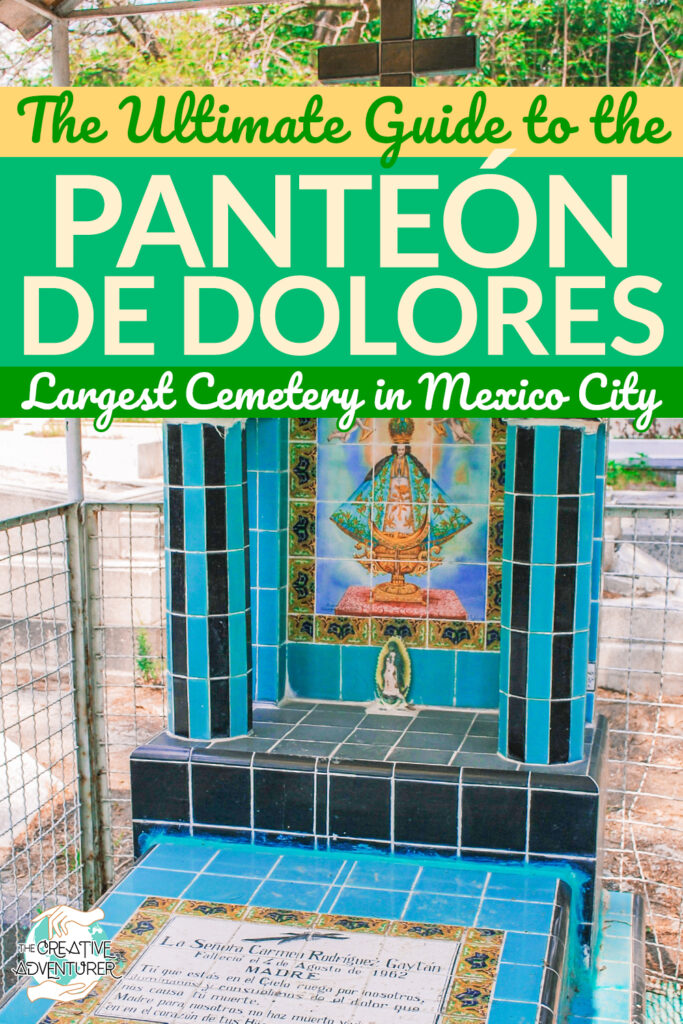
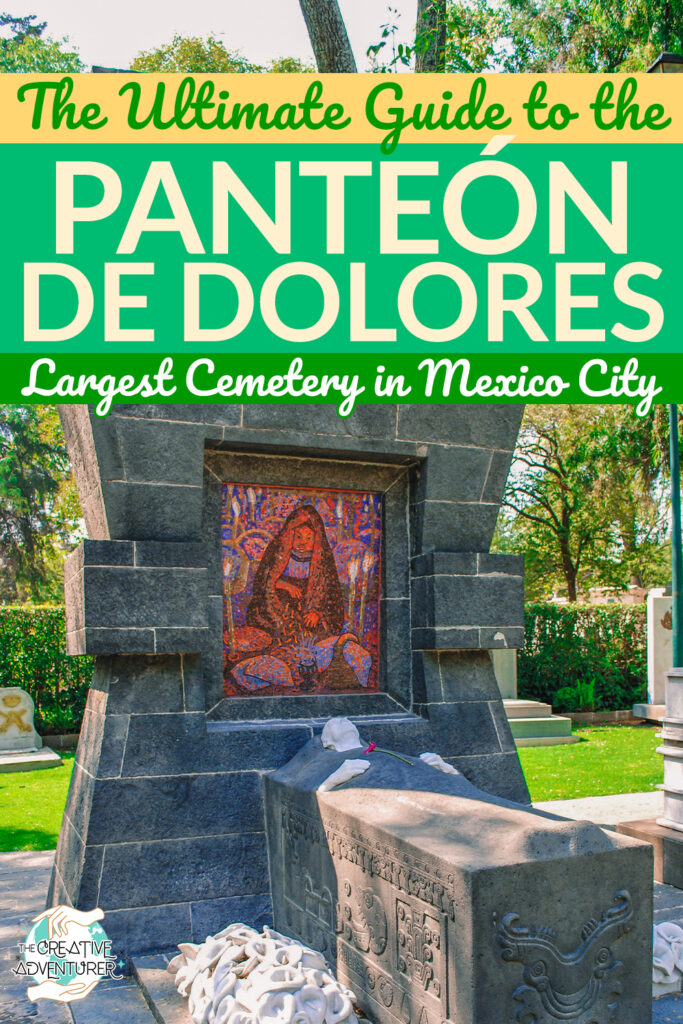
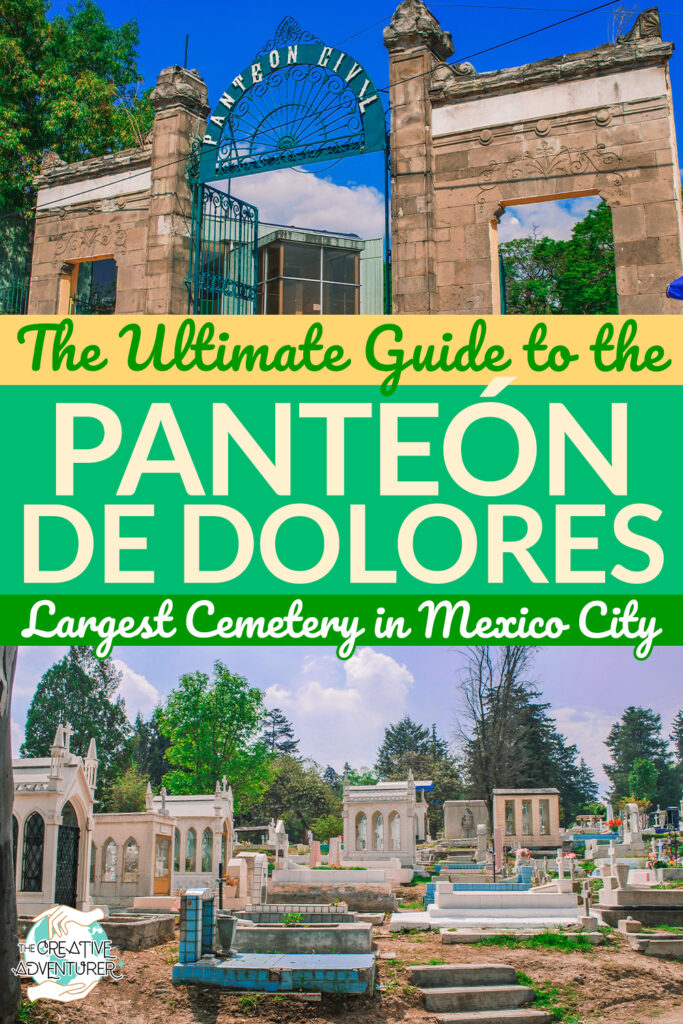
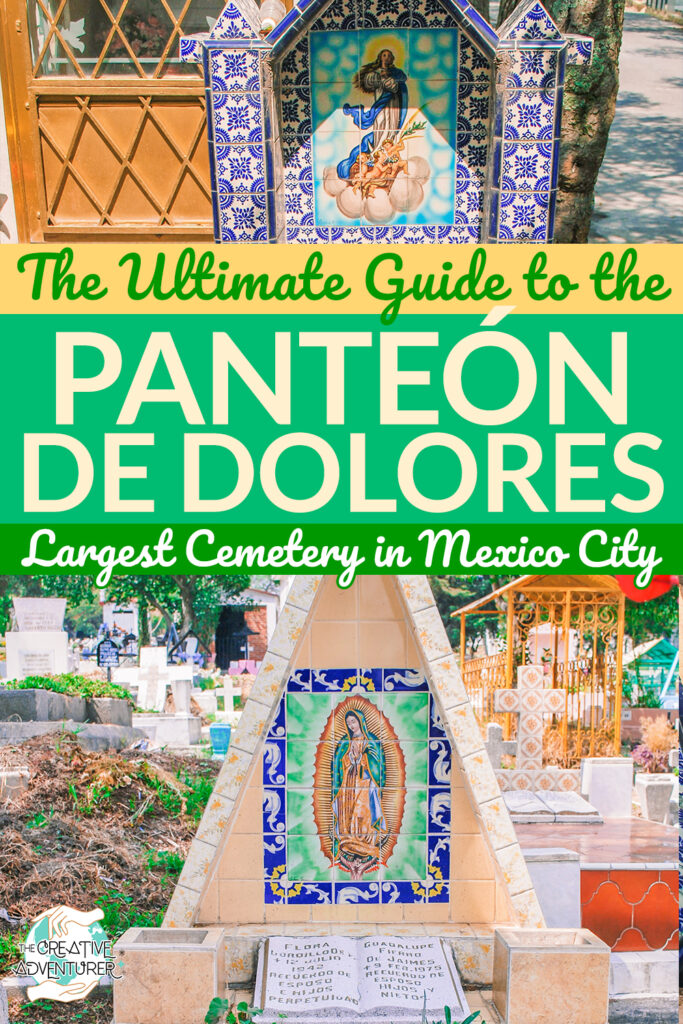



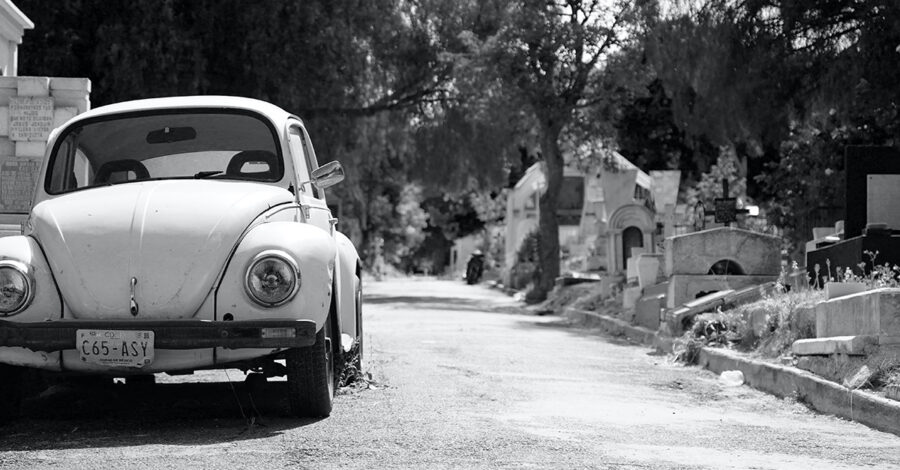

 .
.

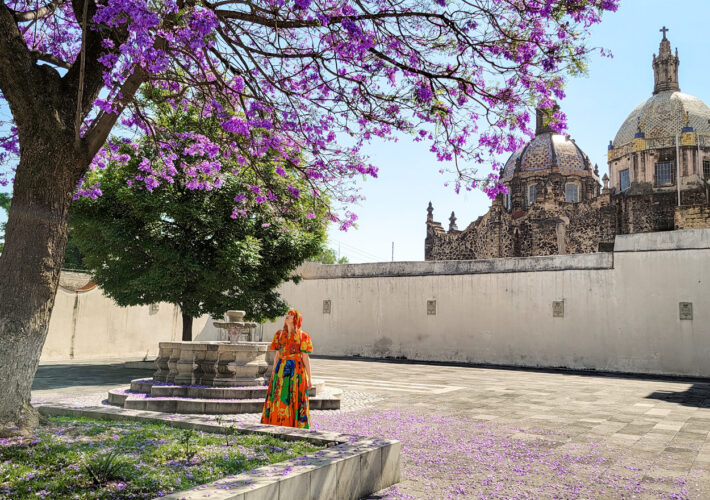
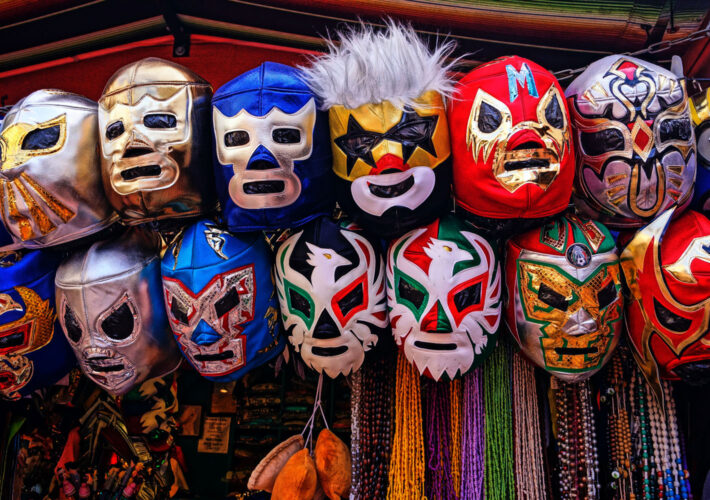
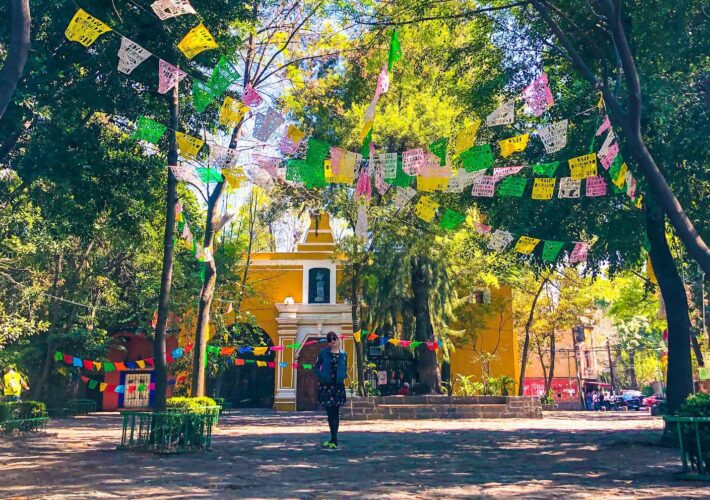

2 COMMENTS
Eduardo Cremer
3 years agoThe story as described has been significantly romanticized. William and Mary Elizabeth Benfield were my great-great- great grandparents and Juan Manuel Benfield was my great-great grandfather. Mary Elizabeth was not miraculously cured upon arrival in Mexico though she was able to live an extra twenty years in Mexico. Soon after she died William Benfield left Mexico and eventually settled in Canada. This was likely due to him not being happy in Mexico. When they arrived in Veracruz their baby daughter did die from cholera but Juan Manuel had not been born yet. No ither family members died. It is true they had to bury her on the beach because of their religion
laura.f.whelan
3 years ago AUTHORWow, thanks for commenting Eduardo! I always try to do my best in researching but I am so happy to make those corrections! No better source than from the family. Feel free to let me know any other pieces of history you have regarding the cemetery, I’d love to learn more.
Feel free to let me know any other pieces of history you have regarding the cemetery, I’d love to learn more.